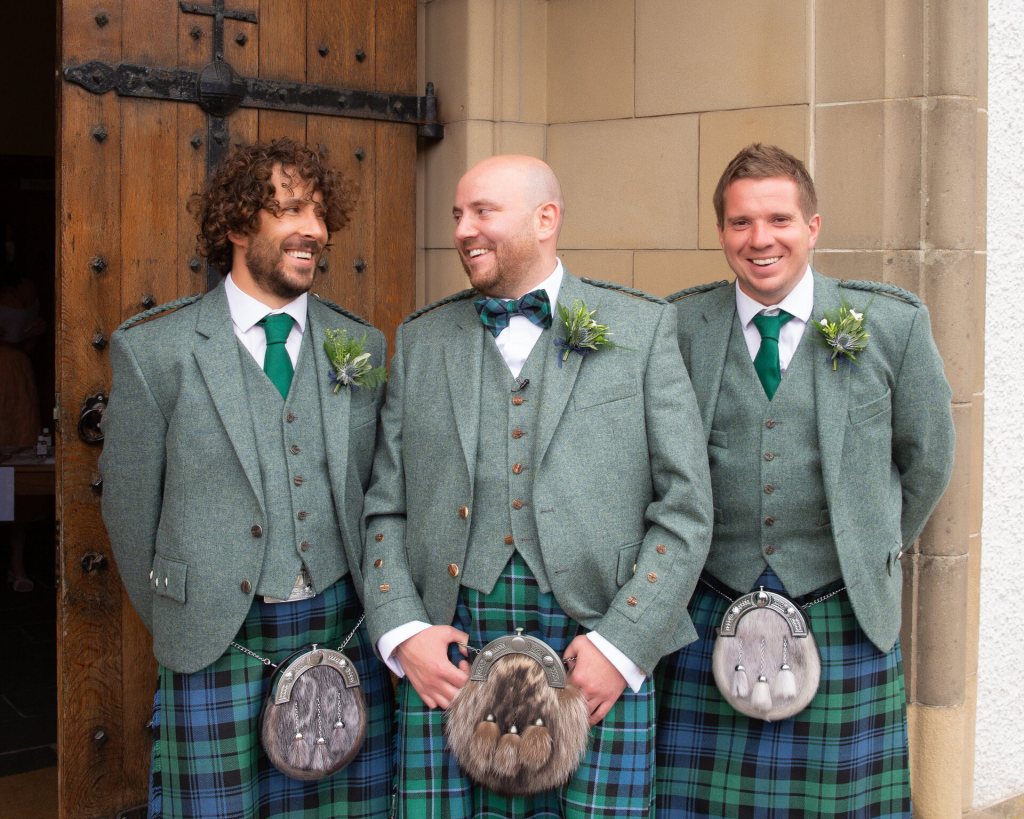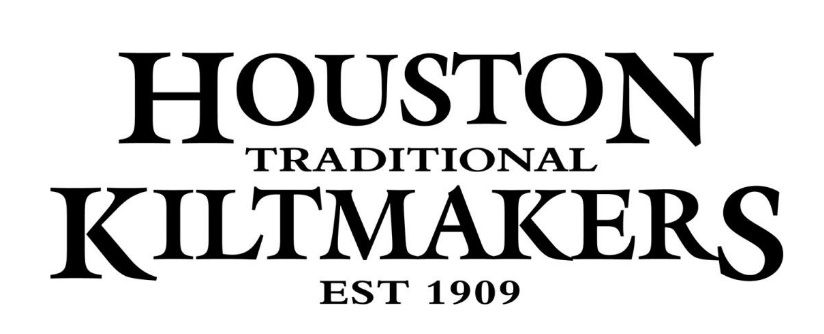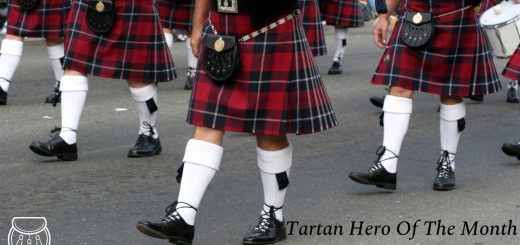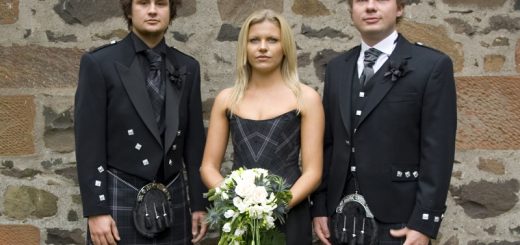Kilt facts – Everything you need to know
Kilts have been around for centuries and are a key part of Scottish culture and identity. But what do we actually know about them?, well there are lots of well accredited tartan and kilt specialists who research everything we know and aim to know about tartans and kilts. This blog covers the basic kilts facts everything you need to know.

How to wear a kilt-
A complete kilt outfit is many pieces and even though there is no kilt police. There is a correct order and way to put them on. This is how to put on a kilt:

1- Firstly put your shirt, cufflinks and socks on. Your kilt socks should sit folded over just below the knee.
2- Next unbuckle your kilt and hold your inside apron against the front of your waist ( note the inside apron is the apron with no fringing)
3- Buckle Your inner apron to the side buckle and wrap the remaining fabric round the back of your waist and back round to the front, ensuring your pleats are at the back and your kilt buckles up at the front apron.
4- Your kilt should sit around your belly button and feel snug to ensure it doesn’t fall down.

5- You may need a second pair of hands or a mirror to put your sporran on. Hold your sporran Infront of your pelvis just above your hips and loop the chain straps through the beltloops at the back of your kilt and fasten till your sporran sits comfortably and centred.
6- After ensuring your sporran is sitting correct you can put your belt on , looping it through the beltloops and fastening at the front , adjust as needed.
7- Grab your tartan flashes and unclip them, lift up the fold of your socks and wrap one of the flashes around each leg just under the fold and fasten so the tartan flash sits on the side of your calf. Fold your sock back over ensuring your socks are even, straight along with your flashes.

8- Put your ghillie brogues on by slipping into the shoe and crossing the laces over and twist round 3 times. Hold the laces firmly at the ankle & wrap the laces round the back and round to the front tying in a bow to finish. If your laces are slipping you can try tying them slightly lower to prevent laces from falling.
9- Put your tie on followed by your buttoned waistcoat, keep your bottom waistcoat button left opened and followed up with the jacket.
10- Lastly pop on your kilt pin on your outside apron, the kilt pin sits in the bottom left hand corner and only passes through the outside apron. Put your Sgian Dubh down the side of your sock leaving the handle showing outside of the sock.
And just like that you have put on your kilt outfit perfectly, if your looking for a more in-depth tutorial we suggest giving out how to wear a kilt blog available here.

How much does a kilt weight?
Tartan itself comes in 3 variations of cloth weight all of which serve different purposes, the kilts weight will come down to which cloth weight it has been made out of and how big the kilt itself is.
A true Scottish kilt is made of 100% wool tartan, wool is naturally a thicker, durable, warmer fabric in it’s natural qualities.

Tartan cloth comes in 3 main weights :
11oz Light weight cloth – Ideal for Ladies and Boys kilts & small tartan accessories.
13oz Medium weight cloth – Multipurpose.
16oz Heavy weight cloth – Best used for Adult kilts & large tartan accessories.
19/20 oz Regimental weight cloth- Very rarely woven but mostly for Military / older styles of kilt.
Heavyweight cloth is the most common weight of tartan used for kilts. Despite the cloth being heavier in weight, this doesn’t make your kilt any warmer. It is your jacket that will retain heat which is why we supple the best super lightweight breathable jackets for kilt outfits.
The 16oz cloth allows the kilt to have a durable structure and hold its shape & pleats well and sit nicely hanging from the waist .
So how much does a kilt actually weigh?
Well this is factor dependant on the size and length or the kilt and how many pleats there are. As an approximate, a 100% wool 8 yard heavyweight cloth kilt will weigh around 2.3KG.
How much does a kilt cost?
The beauty of a kilt is that it can be completely customised to you, we are proud to offer the largest tartan range available in Scotland but how do we price our premium quality kilts.

To be clear Houston kiltmakers specialises in men’s formalwear highland kilt outfits. We strive on providing high quality, made in Scotland authentic highland wear to everyone. our goal is to make Scotland’s national dress accessible and available to everyone.
Providing this does mean we price our kilts competitively, some places sell cheap, mass produced , bad kilts, rushed and mass made in a foreign country. We only use the best tartan mills in Scotland and our trusted experienced hand kilt makers who ensure every kilt we sell is a statement of excellent quality.
To buy just a kilt on its own, the average cost of a 8 yard 16oz heavyweight kilt is £300-£575+. This is just an average as each kilt is priced individually and will purely depend on which tartan you pick, finishings and how you customise your kilt along with the size of the kilt (i.e. the bigger the kilt the more cloth is needed to create a kilt.)
Ex-hire kilts are more budget friendly if your looking for a kilt to give a new lease of life too. Ex-hire kilts range from £195-£295 depending on stock availability.
Where did kilts come from?
Kilt’s are recognised all over the world as a piece of Scottish identity and culture but where did kilts come from?.
Kilts are most known for linking back to highland Scottish clans. Clans wore different tartans to be able to identify one another. Different clans claimed tartans as their own and were usually associated with the family name or clan chiefs name and worn by clan members as a symbol of community.
Kilts have evolved over time, and started off as one big long piece of woven cloth wrapped & pleated around the body, draped over the shoulder & secured with a belt to provide protection and warmth. This took influence from the woollen cloak and this initial introduction of the kilt is known as a great kilt or Feileadh mor.

The great kilt was used in the 16th century and styled with a tunic. During this period plaids would have been more plain or simple style tartans and represented wealth. Going into the 17th century the great kilt slowly transitioned into the walking/ small kilt which is closer to what we recognise today.
The small kilt was derived from the bottom portion of the great kilt and consisted of one long piece of woven cloth wrapped round the front waist, hand pleated round the back and wrapped back round the front waist and secured with a belt. Thomas Rawlinson changed the small kilt when realising the kilt was more practical with pre-sewn pleats which he implemented into his own kilt and had his employees wear. This led to what is known as a tailored kilt which is essentially what we know today.
History of the kilt-
King George the II implemented the dress act of 1746. This ban seen the punishment of Scots who were caught wearing kilts . This meant with the exception of any highland regiments or military, anyone else caught wearing a kilt would be breaking this law and punished by 6 months imprisonment or 7 years transportation.

King George II did this due to Scots wearing kilts and tartan in connection and support of their monarch/ clan chiefs. The king saw this as a threat to his authority and power and wanted to suppress highland wear culture. The ban led to protesters wearing kilts in protest against it and after 35 years of implementation the ban was finally lifted in 1782.
Societies were formed by Scottish landowners to create awareness and use of ancient highland wear and fast forward, the famous kilt became associated with Scotland and is a key piece of Scottish identity after King George the IV came to Scotland and was seen wearing a kilt.
Scottish highlanders and lowlanders mutually set out our Scottish traditions and wore stylised versions of the kilt. Around this time tartans became symbolic to specific clans and were seen as a method of identification.
Why do people wear kilts?
Kilts in Scotland are traditional formal attire. Kilts are worn all around the world by people of all backgrounds and demographics. Kilts are one of the key aspects of Scottish identity and culture, some choose to wear a kilt to celebrate this or to embrace their Scottish heritage.

Wearing a kilt outfit makes you stand out in the best way possible. suits are grown to be out dated with the rise in popularity of Highland wear outfits. A kilt outfit can be completely customised to you, and reflects your own personality or style.
Wearing a kilt can be sentimental for people, many people feel connected to tartan and Scotland as back of their own background. It could represent them wearing their family name tartan, embracing the country’s beautiful national dress or to feel included and proud of our Scottish heritage. Highlanders and lowlanders fought for the right to wear kilts and many people wear kilts in our of Scotland’s rich history.
Buying a kilt is one of the most efficient and sustainable garments you can buy. you buy a good quality kilt once and it will last you a lifetime, kilts can be worn and styled in various ways to a multitude of events from formal to casual wear. Wool is a 100% natural and renewable material and kilts are designed to last, kilts are often seen passed down generations or upcycled after its product lifecycle.
You can browse our full hire range at Kiltmakers.com and if you have any questions or enquires on kilts, made to measure outfits, we would love to welcome you in store, or you can reach us online at [email protected] or call us on 0141 889 4879.


